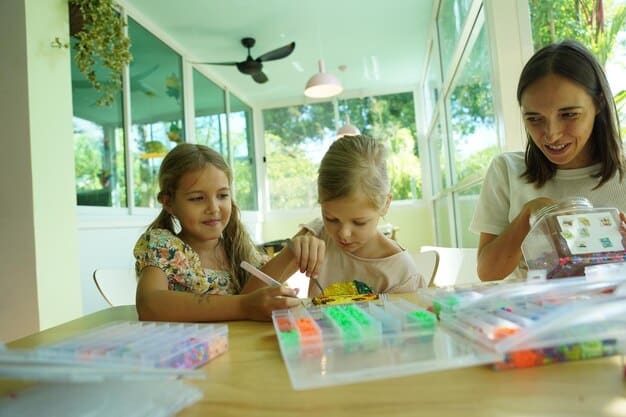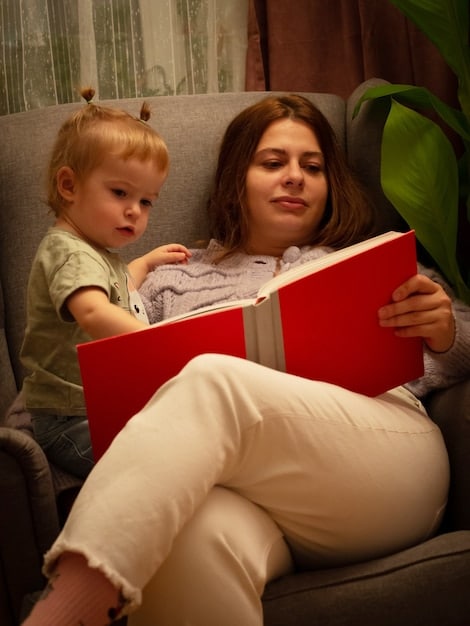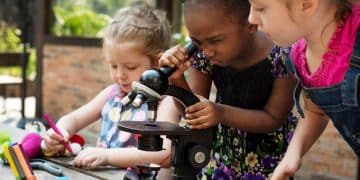Unlock Your Child’s Potential: Understanding Learning Styles

Understanding your child’s learning style—visual, auditory, or kinesthetic—can significantly enhance their educational experience by tailoring learning methods to their natural strengths, fostering engagement, and improving comprehension.
Every child learns differently. Understanding your child’s learning style: visual, auditory, or kinesthetic? is the first step towards unlocking their full academic potential and the key to foster a lifelong love of learning.
The Importance of Identifying Learning Styles
Identifying your child’s learning style isn’t about labeling them, but about understanding how they best receive and process information. It’s about personalizing their learning experience to make it more effective and enjoyable. Imagine the frustration of trying to teach a child through methods that don’t resonate with them – it can lead to disengagement and a negative attitude towards learning.
Recognizing and catering to your child’s learning style can transform their academic journey, boosting their confidence, and making learning a more positive and rewarding experience. By understanding how your child naturally learns, you can adapt your teaching strategies to suit their specific needs, creating an environment where they can thrive.
Why Learning Styles Matter
Understanding learning styles matters because it allows parents and educators to tailor teaching methods to suit the individual needs of each child. This personalized approach can lead to improved comprehension, increased engagement, and a more positive attitude towards learning. When children are taught in ways that align with their natural learning preferences, they are more likely to grasp concepts quickly and retain information effectively.
- Improved comprehension and retention of information.
- Increased engagement and motivation in learning activities.
- Boosted confidence and a positive attitude towards learning.
- Enhanced ability to apply knowledge in real-world situations.

The Impact on Academic Performance
When learning is aligned with a child’s natural preferences, academic performance often improves significantly. Children are able to grasp concepts more easily and retain information for longer periods. This leads to higher grades, increased test scores, and a greater likelihood of academic success. Moreover, when children enjoy the learning process, they are more likely to pursue learning opportunities beyond the classroom.
Conversely, when children are taught using methods that don’t align with their learning style, they may struggle academically and develop a negative attitude towards learning. This can lead to frustration, decreased motivation, and a sense of academic inadequacy. Therefore, understanding and addressing learning styles is crucial for fostering academic success.
In conclusion, recognizing your child’s unique learning style can dramatically improve their educational journey. By adapting teaching methods to align with their preferences, you can foster a love of learning, boost their confidence, and set them up for long-term academic success.
Visual Learners: Learning Through Seeing
Visual learners thrive when information is presented in a way that they can see. They learn best through visual aids such as diagrams, charts, videos, and written instructions. These children often benefit from colorful presentations and demonstrations.
Understanding this preference allows parents and teachers to create a learning environment that supports their visual needs, making learning more effective and enjoyable. By providing visual tools and resources, you can help your visual learner excel and develop a deeper understanding of the material.
Characteristics of Visual Learners
Visual learners have several telltale characteristics. They often have a strong sense of color and are drawn to visually appealing materials. They prefer to read instructions rather than listen to them, and they often doodle or take notes during lectures to help them focus and retain information. These children may also be fascinated by maps, puzzles, and other visually stimulating activities.
- Strong preference for charts, graphs, and diagrams.
- Enjoy reading and often have a vivid imagination.
- Benefit from written instructions and demonstrations.
- Tend to doodle or take notes to help them focus.
These attributes make visual learners stand out in a classroom or home setting, and understanding these traits can guide how you cater to their learning style.
How to Support Visual Learners
Supporting a visual learner involves incorporating visual aids and strategies into their learning routines. Use colorful markers and highlighters to emphasize key points in textbooks and notes. Encourage them to create mind maps and diagrams to organize information. When teaching new concepts, use videos, presentations, and demonstrations to illustrate the material.
Encouraging them to use visual aids and representations can dramatically impact their academic success and enjoyment of learning. By providing resources that cater to their specific needs, you empower them to take control of their education and reach their full potential.

In summary, visual learners excel when they can see the information being taught. By incorporating visual aids and strategies into their learning environment, you can help them thrive and develop a deep understanding of the material.
Auditory Learners: Learning Through Hearing
Auditory learners excel when information is presented through sound. They learn best by listening to lectures, participating in discussions, and engaging in verbal instruction. Auditory learners benefit from repetition, recordings, and opportunities to explain concepts to others.
Recognizing this learning style is crucial for tailoring educational strategies that resonate with them. By understanding how they process information, parents and educators can create a more effective and engaging learning environment.
Characteristics of Auditory Learners
Auditory learners have unique characteristics that set them apart. They often excel in verbal communication and enjoy participating in discussions. These children are good listeners and can easily recall information that has been spoken. They may also benefit from reading aloud or using rhymes and jingles to memorize facts.
- Prefer listening to lectures and discussions over reading.
- Excel in verbal communication and enjoy storytelling.
- Benefit from repetition, recordings, and music.
- Often talk to themselves while problem-solving or studying.
Identifying these characteristics can help parents and educators develop teaching methods that leverage their strengths, making learning a more effective and enjoyable experience.
For instance, providing the opportunity to verbally explain concepts to others can solidify their understanding in ways that visual or kinesthetic methods might not achieve.
How to Support Auditory Learners
Supporting auditory learners involves incorporating sound-based strategies into their learning process. Encourage them to listen to audiobooks, podcasts, and recorded lectures. Provide opportunities for them to participate in group discussions and presentations. When studying, suggest that they read aloud or record themselves explaining concepts, then listen to the recordings.
Engaging with audio-based resources and activities helps auditory learners process and retain information more effectively. By creating an environment that caters to their auditory preferences, you can empower them to take ownership of their learning journey and reach their full potential.
To conclude, auditory learners thrive when they can hear the information being taught. By integrating sound-based strategies into their learning environment, you can support their unique learning style and foster their academic success.
Kinesthetic Learners: Learning Through Doing
Kinesthetic learners learn best through physical activity and hands-on experiences. They thrive when they can touch, move, and interact with their learning environment. These children often benefit from activities such as building models, conducting experiments, and participating in role-playing exercises.
Understanding and accommodating this learning style can significantly enhance their educational experience. By providing opportunities for active engagement, parents and educators can help kinesthetic learners grasp concepts more effectively and develop a genuine love for learning.
Characteristics of Kinesthetic Learners
Kinesthetic learners typically exhibit several distinct characteristics. They enjoy hands-on activities and tend to fidget or move around while learning. These children often learn best by doing rather than simply listening or reading. They may also excel in sports, dance, and other physical activities.
- Learn best through hands-on activities and experiments.
- Enjoy building models, conducting experiments, and role-playing.
- Tend to fidget or move around while learning.
- Excel in sports, dance, and other physical activities.
Identifying these traits can help parents and educators tailor learning methods to suit their kinesthetic needs. When learning is made tangible and interactive, these children often excel.
How to Support Kinesthetic Learners
Supporting kinesthetic learners involves incorporating movement and hands-on activities into their learning routines. Provide opportunities for them to build models, conduct experiments, and participate in role-playing exercises. Encourage them to take breaks and move around while studying. Use manipulatives, such as blocks or puzzles, to help them understand abstract concepts.
Engaging kinesthetic learners through physical activities makes learning more memorable. By creating an environment that fosters movement and interaction, you empower them to take control of their education and reach their full potential.
In conclusion, kinesthetic learners thrive when they can actively engage with their learning environment. By incorporating hands-on activities and movement into their learning routines, you can support their unique learning style and foster their academic success.
Strategies for Combining Learning Styles
While understanding individual learning styles is important, it’s also beneficial to incorporate strategies that combine all three learning styles – visual, auditory, and kinesthetic. This multifaceted approach can cater to a wider range of learning preferences and make educational experiences more engaging and effective. By integrating different methods, you can create a richer and more comprehensive learning environment for your child.
A well-rounded approach ensures that every child benefits, regardless of their dominant learning style. It also helps children develop a more adaptable and versatile approach to learning, preparing them for success in various educational and professional settings.
Multisensory Learning Activities
Multisensory learning activities involve engaging multiple senses simultaneously. For example, when teaching a new language, you might use flashcards (visual), listen to recordings of native speakers (auditory), and practice writing the words (kinesthetic). Similarly, when teaching math, you can use manipulatives (kinesthetic), diagrams (visual), and verbal explanations (auditory). This method helps reinforce learning through different pathways, making it more memorable and meaningful.
- Use flashcards with pictures and words (visual, auditory).
- Engage in hands-on experiments and activities (kinesthetic).
- Listen to lectures, discussions, and audio recordings (auditory).
- Create mind maps and diagrams to organize information (visual, kinesthetic).
The Role of Parents and Educators
Parents and educators play a crucial role in identifying and supporting children’s learning styles. By working together, they can create a cohesive and supportive learning environment that meets the unique needs of each child. This collaboration involves observation, communication, and a willingness to adapt teaching methods to better suit the child’s preferences.
A strong partnership between home and school can significantly enhance a child’s academic journey. When parents and educators are aligned in their approach, children receive consistent support and encouragement, fostering a positive attitude towards learning.
In essence, the combined effort of parents and educators is vital for nurturing a child’s learning potential and fostering a lifelong love of learning.
Observing and Assessing Learning Styles
Parents can start by observing their child’s behavior during learning activities. Pay attention to how they respond to different teaching methods and what activities they seem to enjoy the most. Educators can use formal assessments, such as learning style questionnaires, to gain insights into students’ learning preferences.
These assessments can shed light on a variety of learning styles, including visual, auditory, and kinesthetic. With this knowledge, educators can tailor their teaching strategies to create a more inclusive and effective learning environment.
Creating a Supportive Learning Environment
Creating a supportive learning environment involves providing resources and opportunities that cater to different learning styles. This might include incorporating visual aids in the classroom, encouraging group discussions, and providing hands-on activities. Parents can also support their child’s learning style at home by providing the necessary tools and resources and creating a dedicated study space.
Supportive environments that cater to various learning styles ensures every child has the opportunity to thrive, fostering a positive attitude towards learning and academic success.
| Key Point | Brief Description |
|---|---|
| 🎨 Visual Learning | Learn best through seeing, diagrams, and visual aids. |
| 🎧 Auditory Learning | Thrive through listening, discussions, and verbal instructions. |
| 🖐️ Kinesthetic Learning | Prefer hands-on activities, experiments, and physical movement. |
| 🤝 Combined Strategies | Incorporate visual, auditory, and kinesthetic methods for comprehensive learning. |
Frequently Asked Questions
▼
The three main learning styles are visual, auditory, and kinesthetic. Visual learners learn best by seeing, auditory learners by hearing, and kinesthetic learners through hands-on activities.
▼
Observe your child’s behavior during learning activities. Note what methods they respond to best and what they enjoy most. You can also use online learning style questionnaires.
▼
Understanding learning styles helps tailor teaching methods to suit individual needs, improving comprehension, engagement, and a positive attitude towards learning.
▼
Yes, many children have a combination of learning styles. While one style may be dominant, they can benefit from incorporating strategies that appeal to all three learning styles.
▼
Educators can use a variety of teaching methods, including visual aids, group discussions, and hands-on activities, to cater to different learning styles and create an inclusive environment.
Conclusion
Understanding your child’s learning style is a valuable insight that can transform their educational journey. By recognizing whether they are visual, auditory, or kinesthetic learners, you can tailor your teaching methods to suit their individual needs. This personalized approach not only enhances their comprehension and engagement but also fosters a lifelong love of learning. By embracing their unique learning style, you empower them to reach their full potential and thrive academically.





